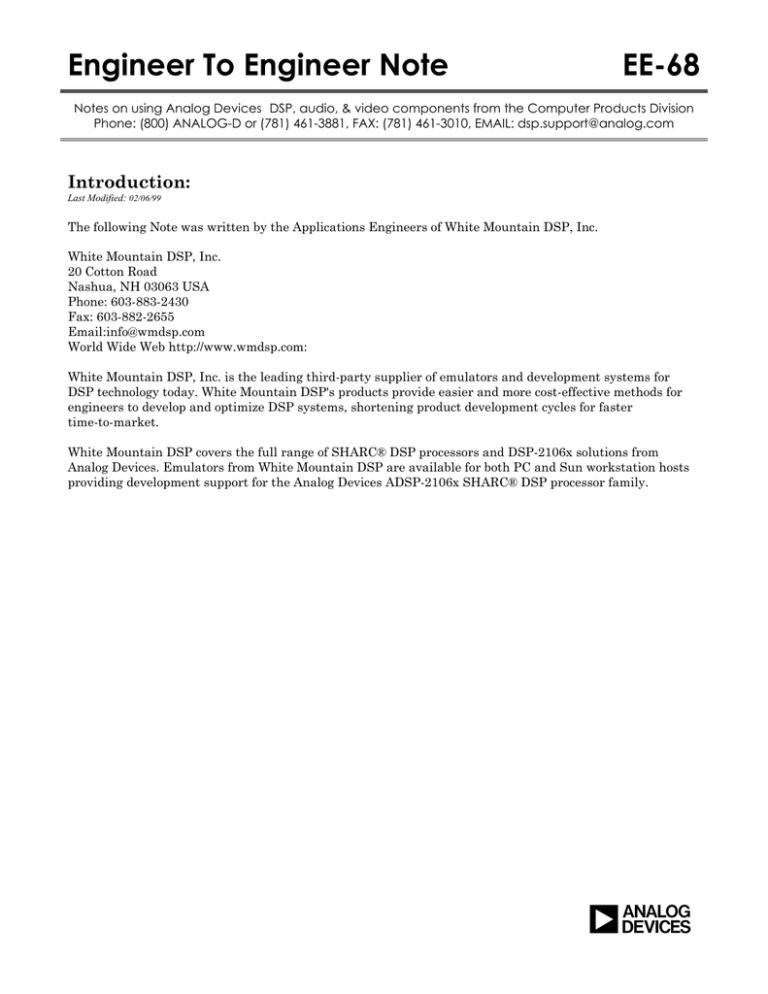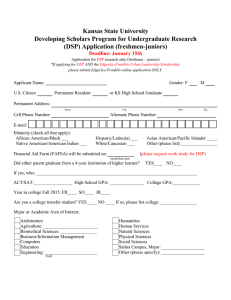
Engineer To Engineer Note
EE-68
Notes on using Analog Devices’ DSP, audio, & video components from the Computer Products Division
Phone: (800) ANALOG-D or (781) 461-3881, FAX: (781) 461-3010, EMAIL: dsp.support@analog.com
Introduction:
Last Modified: 02/06/99
The following Note was written by the Applications Engineers of White Mountain DSP, Inc.
White Mountain DSP, Inc.
20 Cotton Road
Nashua, NH 03063 USA
Phone: 603-883-2430
Fax: 603-882-2655
Email:info@wmdsp.com
World Wide Web http://www.wmdsp.com:
White Mountain DSP, Inc. is the leading third-party supplier of emulators and development systems for
DSP technology today. White Mountain DSP's products provide easier and more cost-effective methods for
engineers to develop and optimize DSP systems, shortening product development cycles for faster
time-to-market.
White Mountain DSP covers the full range of SHARC® DSP processors and DSP-2106x solutions from
Analog Devices. Emulators from White Mountain DSP are available for both PC and Sun workstation hosts
providing development support for the Analog Devices ADSP-2106x SHARC® DSP processor family.
a
White Mountain DSP’s
Inside Edge
TM
APPLICATION NOTES FOR LEADING-EDGE DSP TOOLS
NUMBER 98-1
Analog Devices JTAG Emulation Technical Reference
Contributed by Larry D'Addario, White Mountain DSP, Inc.
This application note describes how to design the interface between an Analog Devices SHARC DSP and the
emulation header on a custom DSP target board. The environment described uses a White Mountain DSP emulator and an Analog Devices (ADI) SHARC DSP as an example. However, this information will apply equally
well to any new JTAG DSPs from ADI.
The White Mountain DSP family of emulators are tools that every SHARC DSP developer needs to test and
debug their hardware and software system. ADI has supplied an IEEE 1149.1 JTAG Test Access Port (TAP) on
each SHARC DSP. The emulator uses the JTAG TAP to access the internals of the DSP, allowing the developer
to load code, set breakpoints, observe variables, observe memory, examine registers, etc.
The last thing an engineer wants to do when testing a new hardware design is debug the emulation port of their
target board. Since the emulation port in many cases is the only vehicle to test a new target board, the emulation
port needs to work flawlessly. The guidelines set forth in this application note are designed to help eliminate
possible problems with the JTAG emulation port.
TARGET BOARD CONNECTOR
The JTAG emulator interface to the SHARC DSP is a 14-pin header, as shown in figure 1. The customer must
supply this header on their target board in order to communicate with the emulator. The interface consists of a
standard dual row 0.025" square post header, set on 0.1" x 0.1" spacing, with a minimum post length of 0.235".
Pin 3 is the key used to prevent the pod from being inserted backwards.
This pin must be clipped on the target board.
As can be seen in figure 1, there are two sets of signals on the header.
There are the standard JTAG signals TMS, TCK, TDI, TDO, TRST,
EMU, and CLKIN used for emulation purposes (via an emulator).
There are also secondary JTAG signals BTMS, BTCK, BTRST, and
BTDI that are optionally used for board-level (boundary scan) testing.
The "B" signals would be connected to a separate on-board JTAG
boundary scan controller if used. Most customers will never use the
"B" signals. If they will not be used, tie all of them to ground except
BTCK. BTCK should be pulled up to VCC (+5 or +3.3) using a 4.7KΩ
resistor, as shown in figure 2.
Figure 1. JTAG Emulator Interface
for SHARC DSP
When the emulator is not connected to this header, place jumpers across
BTMS, BTCK, BTRST, and BTDI as shown in figure 2. This holds the
JTAG signals in the correct state to allow the DSP to run free. Remove
all the jumpers when connecting an emulator to the JTAG header.
Copyright © 1998, White Mountain DSP, Inc. All rights reserved. White Mountain DSP assumes no responsibility for customer product design or the use or application of customers’ products or for
any infringements of patents or rights of others which may result from White Mountain DSP assistance.
Phone: (603) 883-2430
Fax: (603) 882-2655
www.wmdsp.com
info@wmdsp.com
support@wmdsp.com
Figure 2. JTAG Target Board Connector With No Local Boundary Scan
The state of each standard JTAG signal can be found in the following table.
Table 1. State of Standard JTAG Signals
Signal
Description
Emulator
DSP
TMS
TCK
TRST
TDI
TDO
EMU
CLKIN (Optional)
Test Mode Select
Test Clock (10 MHz)
Test Reset
Test Data In
Test Data Out
Emulation Pin
DSP Clock Input
O
O
O
O
I
I
I
I
I
I
I
O
I/O (Open Drain)
I
O = Output, I = Input, I/O = Input / Output
Note the CLKIN signal is presently not used by the emulator. If you are experiencing noise from this signal you
can clip this pin on the 14-pin header. The CLKIN signal may be used for synchronous operations at a future
date. For synchronous operation to work correctly, the CLKIN signal on all the DSPs and the emulator header
must be the same signal and the skew between them must be minimal. If you have no plans for future synchronous operation, simply tie the CLKIN pin to ground on the 14-pin header (do not connect it to the DSP CLKIN
signal).
The final connections between a single SHARC target and the emulation header (within 6 inches) are shown in
figure 3. A 4.7KΩ pull-up resistor has been added on TCK, TDI, and TMS for increased noise resistance.
Should your design use more than one DSP (or other JTAG device), or if your JTAG header is more than 6 inches from the DSP, use a buffered connection scheme as shown in figure 4. Using a buffer that has built in series
resistors such as the 74ABT2244 family will help quell ringing on the JTAG signal lines.
Figure 3. Single DSP Connection to JTAG Header
If you have more than one SHARC DSP on your target, it is imperative that you buffer the JTAG header. This
will keep the signals clean and avoid problems that occur with longer signal traces.
Figure 4. Multiple DSP Connection to JTAG Header
LAYOUT REQUIREMENTS
All JTAG signals (TCK, TMS, TDI, TDO, EMU, TRST, CLKIN) should be treated as critical route signals.
This means pay attention when routing these signals. Specify a controlled impedance requirement for each route
(value depends on your circuit board - typically 50-75Ω). Keep crosstalk and inductance to a minimum on these
lines by using a good ground plane and by routing away from other high noise signals such as clock lines. Keep
these routes as short and clean as possible.
JTAG POD LOGIC
A portion of the emulator pod interface is shown in figure 5. This figure
describes the driver circuitry of the
emulator pod. As can be seen, TMS,
TCK, TRST, and TDI are driven with
a 10Ω series resistor. TDO and
CLKIN are terminated with an
optional 91/120Ω parallel terminator.
EMU is pulled up with a 4.7KΩ resistor. The 74LVT244 chip drives the
signals at 3.3V, with a maximum current rating of ±32mA.
You can parallel terminate the TMS,
TCK, TRST, and TDI lines locally on
your target board, if needed, since
they are driven by the pod with sufficient current drive (±32mA). In order
to use the terminators on the TDO
and CLKIN lines, you MUST have a
Figure 5. JTAG Pod Driver Logic
buffer on your target board JTAG
header and CLKIN signal. The
SHARC DSP is not capable of driving the parallel terminator load directly with TDO. Assuming you have the
proper buffers, you may use the optional parallel terminators simply by placing a jumper on J2 or J3.
POWER SEQUENCE
The power on sequence for your target and emulation system is as follows: apply power to the emulator first,
then to the target board. Removal of power should be the reverse: turn off power to the target board then to the
emulator. Upon power-on, the emulator drives the TRST signal low (releasing the DSP) until the emulation
software takes control.
CONCLUSION
Assuming the concepts described here are followed, designing the JTAG emulation interface for an Analog
Devices SHARC DSP target board is an easy task, and the emulation interface should work with minimal effort.
Valuable debug time can then be spent on the rest of the system (i.e. software and the rest of the hardware).



